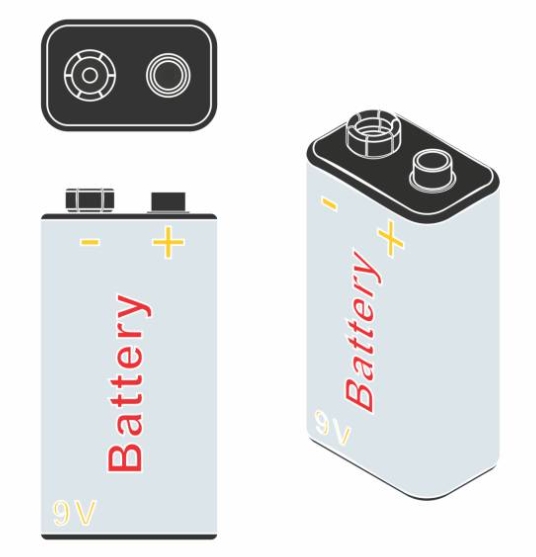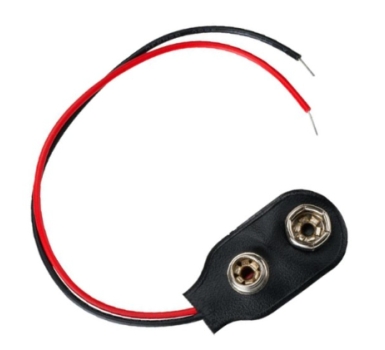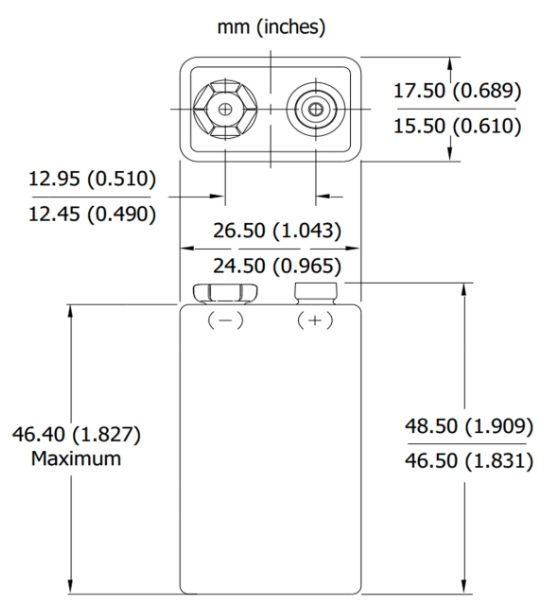9V Battery: Uses, Types and Applications


The 9V Battery is a common small battery widely used in various portable electronic devices. It is known for its reliability and portability, and is an ideal power source for many small devices. This article will introduce the definition, types, uses and application scenarios of the 9V battery in detail.
Definition of 9V Battery
A 9V battery is a DC power source with a voltage of 9 volts (9V), usually in a rectangular shape with dimensions of approximately 26 mm × 44 mm × 17 mm. 9V batteries have high energy density and long service life, and are suitable for various portable electronic devices.
Types of 9V Batteries
9V batteries can be divided into several types according to their chemical composition and structure:
Alkaline batteries:
Definition: Alkaline batteries are the most common type of 9V batteries, using a zinc-manganese dioxide chemical system.
Features:
- High energy density and long life.
- Suitable for devices with low to medium current consumption.
Examples: 9V batteries from brands such as Duracell, Energizer, etc.
Lithium-ion battery:
Definition: Lithium-ion battery is a rechargeable 9-volt battery that uses a lithium-ion chemistry.
Features:
- High energy density and long cycle life.
- Suitable for devices with high current consumption.
Examples: Rechargeable 9-volt batteries from brands such as Panasonic, Sony, etc.
Nickel-cadmium battery (NiCd):
Definition: Nickel-cadmium battery is a rechargeable 9-volt battery that uses a nickel and cadmium chemistry.
Features:
- Long cycle life, but memory effect.
- Suitable for devices with high current consumption.
Nickel-metal hydride battery (NiMH):
Definition: Nickel-metal hydride battery is a rechargeable 9-volt battery that uses a nickel and hydrogen chemistry.
Features:
- High energy density and no memory effect.
- Suitable for devices with medium current consumption.
9-volt battery uses
Wireless devices:
- Wireless mouse and keyboard: 9-volt batteries provide stable power for wireless mouse and keyboard.
- Wireless microphone: used in broadcasting, music performances and other occasions.
- Wireless headphones: wireless headphones suitable for long-term wear.
Security equipment:
- Smoke alarm: 9-volt batteries are a common power source for smoke alarms.
- Security alarm: security alarm system used in homes and commercial places.
- Doorbell: wireless doorbells are usually powered by 9-volt batteries.
Measuring instruments:
- Multimeter: 9-volt batteries provide power for portable multimeters.
- Distance meter: distance meter used in construction and engineering fields.
- Thermometer: portable thermometer and hygrometer.
Toys and models:
- Remote control car: 9-volt battery provides power for remote control car.
- Electronic toys: various electric toys and model airplanes.
- Electronic pet: portable electronic pet toys.
Electronic equipment:
- Electronic calculator: portable electronic calculator.
- Portable audio: small portable audio equipment.
- Portable lights: flashlights, camping lights, etc.
Medical equipment:
- Blood glucose meter: a portable device for measuring blood sugar.
- Heart rate monitor: a portable heart rate monitoring device.
- Portable blood pressure monitor: used in homes and medical settings.
Advantages and disadvantages of 9-volt batteries
Advantages:
- Portability: 9-volt batteries are small, lightweight, and easy to carry.
- High energy density: With high energy density, they are suitable for a variety of devices.
- Wide applicability: Suitable for a variety of portable electronic devices.
- Reliability: Stable performance and long service life.
Disadvantages:
- Higher price: Compared with other types of batteries, the price of 9-volt batteries is relatively high.
- Limited capacity: Limited capacity, suitable for devices with low to medium current consumption.
- Disposable: Disposable 9-volt batteries need to be replaced regularly.
- Inconvenient charging: Rechargeable 9-volt batteries require a special charger.
How to choose a 9-volt battery
Device type:
- Determine the current consumption and voltage requirements of the device.
- Choose the battery type that suits the device type.
Frequency of use:
- Rechargeable 9V batteries are suitable for devices that are used frequently.
- Disposable 9V batteries can be selected for devices that are used less frequently.
Budget:
- Users with sufficient budget can choose high-quality 9V batteries.
- Users with limited budget can choose cost-effective 9V batteries.
Brand:
- Choose 9V batteries from well-known brands to ensure quality and performance.
Maintenance and care of 9V batteries
Storage conditions:
- Store in a dry, cool place, avoid high temperature and humidity.
- Avoid contact with other metal objects to prevent short circuits.
Regular inspection:
- Check the battery regularly for leakage or damage.
- Replace aging batteries in time to ensure normal operation of the device.
Charging precautions:
- For rechargeable 9V batteries, use a dedicated charger.
- Follow the correct charging procedure to avoid overcharging.
Recycling:
- Used 9V batteries should be properly disposed of to avoid environmental pollution.
- Choose a regular battery recycling channel for environmentally friendly disposal.
Which 9V battery has the longest service life?
The service life of a volt battery is affected by many factors, including the battery's chemical composition, capacity, usage conditions, and storage methods. Here is a comparison of the service life of several common 9-volt batteries:
1. Alkaline battery
Features:
- The most widely used 9-volt battery.
- High energy density, suitable for devices with long-term low current consumption.
- Usually not rechargeable, it is a disposable product.
Service life:
- The service life of alkaline 9-volt batteries is usually around 6 months to 2 years.
- If stored properly, unopened alkaline 9-volt batteries can be stored for many years.
- Under storage conditions, a shelf life of 5 years is common.
2. Lithium-ion battery
Features:
- High energy density, suitable for devices that require high current.
- Rechargeable, long cycle life.
Service life:
- The service life of lithium-ion 9-volt batteries depends on the number of charges and usage conditions.
- Under normal circumstances, lithium-ion batteries can still retain most of their capacity after hundreds of charge and discharge cycles.
- The shelf life is more than ten years at room temperature, and the annual self-discharge is less than 2%.
3. Nickel-cadmium battery (NiCd)
Features:
- Rechargeable, suitable for frequently used devices.
- There is a memory effect, and it needs to be fully charged and discharged regularly to maintain optimal performance.
Service life:
- Nickel-cadmium batteries have a long cycle life and can be charged and discharged hundreds of times.
- The service life depends on the number of charge and discharge cycles and the conditions of use.
4. Nickel-metal hydride batteries (NiMH)
Features:
- Rechargeable, no memory effect, suitable for devices that require high current.
- Usually have higher energy density than nickel-cadmium batteries.
Service life:
- NiMH batteries can be charged and discharged hundreds of times and have a long cycle life.
- Suitable for devices that are used for a long time, such as wireless mice, keyboards, etc.
5. Lithium batteries
Features:
- High energy density, suitable for devices that require high current.
- Rechargeable, long cycle life.
Service life:
- The service life of lithium batteries depends on the number of charge and discharge cycles and the conditions of use.
- Usually, lithium batteries can still maintain most of their capacity after hundreds of charge and discharge cycles.
- For example, the Energizer lithium battery 9V is said to last for 20 years.
Comprehensive analysis
Is a 9V battery just 6 AAA batteries?
A 9V battery is not made up of 6 AAA batteries. In fact, a 9V battery is a specially designed type of battery with a nominal voltage of 9V and unique physical specifications. According to Sogou Baike, the internal structure of a 9V battery is 6 stacked miniature sheet batteries3. Each of these sheet cells has its own positive electrode, negative electrode and electrolyte, and is connected in series to provide a total voltage of 9V. This construction is different from the arrangement of ordinary AAA batteries.
AAA batteries, also known as No. 7 batteries, are standard cylindrical batteries with a voltage of usually 1.5V and a small size of about 10.1mm in diameter and about 43.6mm in height18. In contrast, the dimensions of a 9V battery are 26.5mm in width, 17.5mm in thickness and 48.5mm in height3, which is obviously not suitable as a direct component of a 9V battery.
Although it is theoretically possible to achieve a voltage of 9V by connecting six 1.5V batteries (either AA or AAA) in series, in practice this does not produce a true 9V battery because such a combination would not conform to the standard size and packaging of 9V batteries. In addition, such a makeshift combination may be unstable and unsuitable for applications that require fixed installation.
In short, a 9V battery is a specially designed battery that is not simply a combination of ordinary AAA batteries.
Can I use any 9V battery for a smoke alarm?
When choosing a 9V battery for a smoke alarm, you should make sure that the selected battery is suitable for your device and meets the manufacturer's recommendations. Most smoke alarms require a specific type of 9V battery. There are two main types of common 9V batteries: alkaline batteries and carbon-zinc batteries. In addition, there are rechargeable 9V nickel-cadmium (NiCd) or nickel-metal hydride (NiMH) batteries.
What is the relationship between 9v battery and 9v battery connector?

A 9V battery is a portable power supply device that provides direct current (DC), and the voltage it produces is 9 volts. This battery is commonly used in a variety of small electronic devices, such as smoke detectors, wireless microphones, some toys, and other portable devices.
A 9V battery connector (or adapter) is an interface component used to connect a 9V battery to a device. It usually includes a clip or plug that can be securely connected to the positive and negative contacts of the 9V battery, and the other end can be a specific plug or lead for plugging into the device that needs to be powered. This connector helps ensure good electrical contact between the battery and the device and simplifies the installation and replacement of batteries.
In some cases, a 9V battery connector can also be part of the device, such as a battery box or battery holder, allowing users to easily insert or remove 9V batteries without having to fiddle with wires or connectors every time.
In summary, the 9V battery provides power, and the 9V battery connector provides a way to safely and reliably pass this power to the desired device. The two are used together to ensure the efficient transmission of power.
Are all 9V batteries the same size?
The vast majority of 9V batteries (model 6F22 or MN1604) have standard dimensions, which means that they should be the same in physical size. This standard size was established by organizations such as the International Electrotechnical Commission (IEC) and the Battery Council International (BCI) in the United States to ensure interchangeability and compatibility.
The general dimensions of a 9V battery are as follows:
Length (width): about 26.5 mm
Thickness: about 17.5 mm
Height: about 48.5 mm

If you purchase an industry-standard 9V battery, then regardless of brand, they should have the same physical dimensions and be interchangeable in devices designed to accept such batteries. Before purchasing, it is best to confirm the actual dimensions of the battery to ensure that it will work in your device.
What is a 9v battery equivalent to?
Voltage Equivalence
Physical Equivalence
Chemical Equivalence
Capacity Equivalence
Summary
The 9-volt battery is a small battery widely used in various portable electronic devices. It is known for its portability, high energy density, and wide applicability. Choosing a suitable 9-volt battery requires considering factors such as device type, frequency of use, budget, and brand. Through reasonable maintenance and care, the service life of the 9-volt battery can be extended to ensure the normal operation of the device. Understanding the characteristics and application scenarios of the 9-volt battery will help you better choose and use the appropriate battery.
Statement
All articles (images, texts, audio) on this site are uploaded and shared by users, or integrated from relevant internet sources, only for user's learning. If your rights are violated, please contact the administrator to delete! Link to this article: https://www.jinftry.com.







